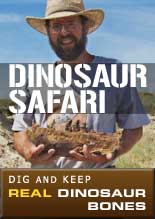
This is your opportunity to own an authentic Nanotyrannus dinosaur tooth. Imagine holding this tooth in your hand. Envision the power of the living dinosaur that once had this tooth. Feel the serrated edges that cut through flesh and bone. Imagine the bone crushing force of its bite. Hold this tooth in your hand and know the terror its prey must have felt some 65 million years ago.
This 1.36 inch tooth was collected June 2005, Powder River County, Montana, Hell Creek Formation. Excellent enamel and color with serrations. There is limited crack repair but no restoration. Comes in 4.25 x 3.25 Riker Mount.
Name: Nanotyrannus (Dwarf tyrant).
Phonetic: Nah-no-ty-ran-nus.
Named By: Robert T. Bakker, Phil Currie & Michael Williams - 1988.
Synonyms: Gorgosaurus lancensis, Deinodon lancensis, Aublysodon lancensis, Albertosaurus lancensis.
Classification: Chordata, Reptilia, Dinosauria, Saurischia, Theropoda, Tyrannosauridae.
Species: N. lancensis (type).
Diet: Carnivore.
Size: Approximately 5.2 meters long for holotype.
Known locations: North America.
Time period: Maastrichtian of the Cretaceous. 72-66 million years ago.
Nanotyrannus is probably the most controversial member of the Tyrannosauridae because while some palaeontologists think that it represents a distinct genus, others think that it is simply a juvenile form of a larger tyrannosaurid genus, or even a dwarf species of another genus. Indeed when the skull was first described by Charles W. Gilmore in 1946 it was classified as a species of Gorgosaurus.
The controversy surrounding Nanotyrannus began in 1988 when during a re-examination of the skull by Robert T. Bakker, Phil Currie and Michael Williams, the skull bones where perceived to have been fused together. This is typically a sign of an adult individual as the skull bones of individual animals remain separate while in the juvenile stages for easier growth. When the growth begins to slow down the bones become fused together for additional strength during the animal’s adult life.
However in 1999 another palaeontologist named Thomas Carr conducted a detailed analysis on the skull and found that the bones were not actually fused together after all. This observation split palaeontologists all over the world into thinking that Nanotyrannus was either a small tyrannosaurid or a juvenile of a larger one. Debate continued to sway one way or the other until the discovery of a new tyrannosaur specimen that was nicknamed ‘Jane’. Not only was Jane the same size and species as Nanotyrannus, but Jane was without doubt a juvenile tyrannosaur. In light of this new discovery many of the palaeontologists who had supported the idea that Nanotyrannus was a new genus now switched to the idea that Nanotyrannus really was a juvenile of another genus, including Phil Currie and Michael Williams. Other palaeontologists still however think that Nanotyrannus deserves to be placed within its own genera because it is still different enough from other known forms.
Initially Nanotyrannus was thought to be a juvenile tyrannosaurid (possibly of Tyrannosaurus) because of the large number of teeth that were present a study that showed a correlation between tyrannosaurids reducing the numbers of teeth as they aged. The problem with this study however is that it only supplied a few examples, and not only do some genera like Tarbosaurus show roughly the same amount of teeth between adults and juveniles, but other genera show a great discrepancy between the number of teeth present in individuals of the same age and genus. This is why teeth count is no longer considered a reliable identifying feature for age and genus.
There only remains one feature that is present upon the Nanotyrannus holotype and the Jane specimen that may save Nanotyrannus as being a valid genus and this is a small pit in the quadratojugal at the back of the skull. This remains unknown in the specimens of other juvenile tyrannosaurids and is so far not present in any known adults. Unless this proves to be a feature that grew out as the animal reached adulthood it may become the identifying feature of the genus. From http://www.prehistoric-wildlife.com/species/n/nanotyrannus.html.
Authentic Fossil
1.36 Inches
Item 3414
Category: Authentic Fossils
Type: Teeth
Phylum: Vertebrates
Class: Dinosaurs
MORE PHOTOS:
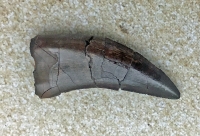
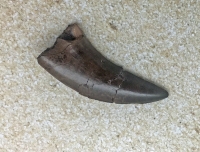
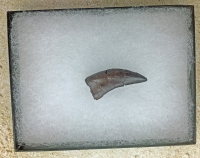
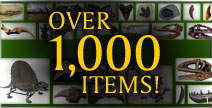
Now Over 1,000 Items!
PrehistoricStore.com offers the largest selection of replica fossils and other fossil-related products anywhere in the world!
Download a Full Catalog (3MB PDF)
OVER 260 PAGES OF REPLICAS AND MORE!
